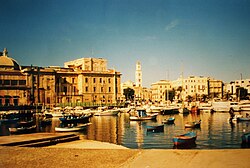TheMetropolitan City of Bari(Italian:città metropolitana di Bari) is ametropolitan cityin theApuliaregion ofItaly.Its capital is the city ofBari.It replaced theprovince of Bariand includes the city ofBariand some forty othercomuni(sg.:comune). It was first created by thereform of local authorities (Law 142/1990)and then established by the Law 56/2014. It has been operative since January 1, 2015.
Metropolitan City of Bari
Città metropolitana di Bari(Italian) | |
|---|---|
 Bari Harbour | |
 Map highlighting the location of the Metropolitan City of Bari in Italy | |
| Country | |
| Region | Apulia |
| Capital(s) | Bari |
| Comuni | 41 |
| Government | |
| • Metropolitan Mayor | Vito Leccese |
| Area | |
• Total | 3,825 km2(1,477 sq mi) |
| Population (2023) | |
• Total | 1,222,143 |
| • Density | 320/km2(830/sq mi) |
| GDP | |
| • Metro | €28.220 billion (2015) |
| • Per capita | €22,945 (2015) |
| Time zone | UTC+1(CET) |
| • Summer (DST) | UTC+2(CEST) |
| Postal code | 70001–70100 |
| Telephone prefix | 080, 0883 |
| Vehicle registration | BA |
| ISTAT | 272[2] |
The Metropolitan City of Bari is headed by the Metropolitan Mayor (sindaco metropolitano) and by the Metropolitan Council (consiglio metropolitano). Since 1 January 2015Antonio Decaro,as mayor of the capital city, has been the first mayor of the Metropolitan City.
It has an area of 3.825 km2(1.477 sq mi) and a population of 1,222,143 (2023).[3]
| Year | Pop. | ±% |
|---|---|---|
| 1951 | 928,366 | — |
| 1961 | 981,507 | +5.7% |
| 1971 | 1,060,037 | +8.0% |
| 1981 | 1,154,535 | +8.9% |
| 1991 | 1,202,704 | +4.2% |
| 2001 | 1,218,038 | +1.3% |
| 2011 | 1,247,303 | +2.4% |
| 2021 | 1,226,784 | −1.6% |
| Source:ISTAT | ||
Geography
editOverlooking theAdriatic Seain south-eastern Italy, the Province of Bari is located in the central part of Apulia and is bordered on the west by the provinces ofMateraandPotenza,to the north by the province ofBarletta-Andria-Trani,and to the south by the provinces ofTarantoandBrindisi.The province of Bari was formerly a part of the region ofTerra di Bari,which once included the towns ofFasanoandCisternino,now in the province of Brindisi.[4]
The area is dominated by theMurgiahills in the inner part, akarstplateau which is the home of theAlta Murgia National Park,one of the newest national parks in Italy, established in 2004.[5]Only the Bari hinterland and the coastal strip are flat. The north of the province, with Bari,Altamura,Bitonto,Corato,Gravina in Puglia,andMolfetta,is heavily populated. The south, on the contrary, is characterized by the absence of these large centers; the only municipality to be around 50,000 inhabitants isMonopoli.In the southern part of the province, on the border with that of Taranto, is theItria Valley,between the towns ofAlberobello,Locorotondo,Cisternino andMartina Franca.The province is largely devoid of rivers and lakes, although underground rivers in the karst landscape has formed numerous caves, including those ofCastellanaandPutignano.[6]
Cities and comunes
editWith the establishment of theProvince of Barletta-Andria-Traniin 2004, in addition to the provincial capitals, the province of Bari lost another 4 municipalities, i.e.Bisceglie,Canosa di Puglia,Minervino MurgeandSpinazzola. This left the remaining Province of Bari with 41comuniand an adjusted population of 1,248,084 as of the 2005 census.[3]
- Acquaviva delle Fonti
- Adelfia
- Alberobello
- Altamura
- Bari
- Binetto
- Bitetto
- Bitonto
- Bitritto
- Capurso
- Casamassima
- Castellana Grotte
- Cellamare
- Conversano
- Corato
- Gioia del Colle
- Giovinazzo
- Gravina in Puglia
- Grumo Appula
- Locorotondo
- Modugno
- Mola di Bari
- Molfetta
- Monopoli
- Noci
- Noicattaro
- Palo del Colle
- Poggiorsini
- Polignano a Mare
- Putignano
- Rutigliano
- Ruvo di Puglia
- Santeramo in Colle
- Sannicandro di Bari
- Terlizzi
- Toritto
- Triggiano
- Turi
- Valenzano
Government
editList of Metropolitan Mayors of Bari
edit| Metropolitan Mayor | Term start | Term end | Party | |
|---|---|---|---|---|
| 1 | Antonio Decaro | 1 January 2015 | 9 July 2024 | Democratic Party |
| 2 | Vito Leccese | 9 July 2024 | Incumbent | Democratic Party |
Economy
editThe arable land in the province of Bari is exploited with the cultivation ofoliveandgrapes,but also cherries,peaches,andalmonds.From that agricultural activity is derivedolive oil,wineand table grapes.[7]Bitonto is especially noted for its extra virgin olive oil, andCorato(with theCoratinaolive variety) and Giovinazzo are along notable producing areas. The centers of wine production are mainly concentrated inGravinaandRuvo di Puglia,in the north of Bari, andAdelfia,Noicattaro,RutiglianoandLocorotondo,in the south of Bari. Also important is the production of cherries; the Apulian red is especially prevalent in the countryside ofTuriandPutignano.[8]
See also
editReferences
edit- ^Regions and Cities > Regional Statistics > Regional Economy > Regional Gross Domestic Product (Small regions TL3),OECD.Stats. Accessed on 16 November 2018.
- ^"Codici delle città metropolitane al 1° gennaio 2017".istat.it(in Italian). 23 December 2016.
- ^ab"Statistiche".Upinet.it. Archived fromthe originalon 7 August 2007.Retrieved28 September2014.
- ^Iaccarino, Luca (2011).Puglia e Basilicata(in Italian). EDT srl. p. 27.ISBN978-88-6040-798-6.
- ^Hardy, Paula; Hole, Abigail; Pozzan, Olivia (2008).Basilicata.Lonely Planet. p. 54.ISBN978-1-74179-089-4.
- ^Christoph, Jacqueline (2 May 2014).DuMont Reise-Handbuch ReisefŸhrer SŸditalien.DuMont Reiseverlag. p. 333.ISBN978-3-7701-7750-9.
- ^Lago, Enrico Dal (2005).Agrarian Elites: American Slaveholders and Southern Italian Landowners, 1815-1861.LSU Press. p. 202.ISBN978-0-8071-3087-2.
- ^Rivista di frutticoltura e di ortofloricoltura(in Italian). Grupo Giornalistico Edagricole. 1997. p. 20.

